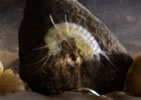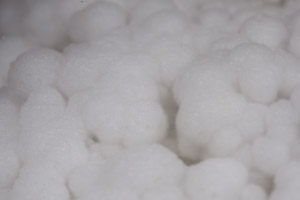 |
 |
| |
| HOME |
| INTRODUCTION |
| LIFE IN THE ENTRANCE |
| LIFE IN THE CAVE |
| CONSERVATION |
| GLOSSARY |
| ACKNOWLEDGEMENTS |
| Bacteria |
| Fungi |
| Plants, Algae & Protozoans |
| Flatworms |
| Eelworms & Segmented Worms |
| Slugs & Snails |
| Crustacea |
| Insects |
| Spiders & Millipedes |
| Fish & Amphibians |
| Birds |
| Bats |
| Fossils and archeology |
Bacteria |
|
There are many species of bacteria found in the cave environment, most of which you will not notice as they are individually minute. Between them they have a variety of lifestyles including photoautotrophs that use photosynthesis, chemoautotrophs that use other chemical processes to obtain energy from minerals and gases, heterotrophs that gain energy from existing organic compounds. Bacteria are prokaryotes - single celled organisms.
PHOTOAUTOTROPHIC BACTERIA
Cyanobacteria (formerly known as blue-green algae due to a blue photosynthetic pigment, phycocyanin) are an ancient group of organisms and live in many places where nothing else can survive. There are fossils of cyanobacter dating back for nearly 4 billion years when our climate was very different. Cyanobacter are easily seen in the thresholds of caves or in show caves where there is some light and moisture. They are best seen in dimly lit areas growing on the rock, in these areas the levels of light are too low for eukaryotes (multicelled organisms) to survive. They appear in a variety of colours, in fact any colour other than bright green. They are typically blue-green, blue-black or black. Secondary pigments may colour them yellow, brown, red, purple.
Most cyanobacter use light as their energy source to convert carbon dioxide into sugars, producing oxygen as a by-product. In the presence of oxygen they can reduce carbon dioxide and nitrogen, but in anaerobic conditions they can use hydrogen sulphide, even atmospheric hydrogen and respire anaerobically. Most have chlorophyll a and a few have chlorophyll b.
Some species form resistant heterocysts when conditions become tough, these cysts can convert nitrogen into ammonia, nitrite or nitrate. On the nutrient deficient surface of limestone rock faces a thin grey/black film of cyanophilic algae may be present - these can fix their own nitrogen from the air.
Some species of cyanobacter are closely associated with travertine and a number can deposit calcium carbonate. Cyanobacter found in caves include the oligotrophic freshwater Synechococcus elongatus (which is associated with moonmilk), and Anacystis montana which is often found near the lights in show caves.
Many cyanobacter are capable of producing lipopolysaccharides that irritate the skin, a species of Lyngbya is responsible for one of the skin irritations commonly known as "swimmer's itch."
CHEMOAUTOTROPHIC BACTERIA
In the dark zone of a cave bacteria cannot use the sun's energy to convert carbon dioxide to organic compounds (photosynthesis), and so they use a variety of other metabolic pathways. These bacteria that make their own food (autotrophy) using chemicals and minerals as their source of energy (chemo) and so are called chemoautotrophic bacteria. They obtain energy by the oxidation or reduction of simple inorganic substances (e.g. iron, sulphur, nitrogen). They only need simple inorganic elements to survive e.g. iron or sulphur, moisture, carbon dioxide and a few trace elements to survive, they do not need sunlight like green plants. In British mines (and caves) Ferrobacillus ferrooxidans uses carbon dioxide as its carbon source and oxidizes iron to obtain energy. Sulphur reducing and oxidizing bacteria are usually found near shale rock containing pyrite.
Nitrifying bacteria are chemoautotrophic bacteria that obtain energy by the oxidation of ammonia to nitrite e.g. Nitrosomonas, or nitrate e.g. Nitrobacter. This oxidation process is their source of energy, they obtain carbon from carbon dioxide. The energy produced is very small but they are extremely efficient at this process, most of the energy goes towards fixing carbon so there is not much left for growth. They secrete a sticky slime matrix which they use to attach themselves to a substrate such as gravel or flowstone. They cannot survive desiccation so the damp underground environment suits the group. Nitrobacter oxidise ammonia to nitrous and nitric acid that can dissolve limestone.
Other bacteria that have been found in caves include the Gram-negative aerobic Clostridium and Azobacter that are able to obtain nitrogen from the air and convert it into nitrogen compounds. Relatively few organisms can 'fix' nitrogen gas in this way and all of them are bacteria.
These bacteria are probably crucial to the survival of other cave dwellers deep in a cave (e.g. Collembola) as they are at the base of the food chain.
HETEROTROPHIC BACTERIA
Like humans these obtain their energy from readymade organic food molecules that they find in their environment. Heterotrophic filamentous bacteria have been found growing on flowstone in caves but where these bacteria obtain their source of organic food is not clear.
Leptospirosis For cavers the most important heterotroph is the spirochaete bacterium Leptospira interrogans which causes Weil’s disease. There are over 180 strains of this bacterium; the most serious infections are carried by the brown rat. 9% of British cavers carry antibodies demonstrating some prior contact with the pathogen, although most infections do not develop into Weil’s disease.
Weil's disease is caught by direct or indirect exposure to rat urine. Rats are a host animal for Leptospira interrogan var Icterohaemorrhagiae bacteria. High numbers of these bacteria can be present in the kidneys of the rat (100,000,000,000-bacteria/per gram). The bacteria pass out into the environment when the rats urinate and cavers can then be infected by contact with contaminated water or moist soil. The Leptospires enter the caver's body through cuts and abrasions, also via the mucous membranes of the nose, mouth or eyes. Luckily rats do not generally live in caves as there is not enough food, you are most likely to see them if the cave is in very close proximity to a farm. The disease is biphasic - the first phase (4-14 days after infection) is much like flu, after an apparent recovery the victim then suffers from a variety of symptoms including meningitis, liver damage and renal failure. Most infections do not develop into Weil’s disease, the small number that do can kill if not treated. Diagnosis of the disease is difficult as symptoms are so varied, there is no vaccination available.
Cavers are at risk of contracting Weils disease in a number of caves in the Peak District including Long Tor Grotto and Youd's Level.
The Actinobacter are a group of Gram positive bacteria. They include the antibiotic producing actinomycetes which resemble fungi with their elongated branching cells. They are often responsible for the damp mouldy smell in caves and the scent in the outside air when it rains. The smell is the chemical geosmin and is produced by several classes of microbes, including cyanobacteria (blue-green algae) and actinobacteria (especially streptomyces), and released when these microbes die. The human nose appears to be extremely sensitive to it. Many cause disease in humans but some possess antibiotic properties which may be why moonmilk has been used as a wound dressing and cavers with colds report cold symptoms disappearing underground. Some Actinomycetes synthesise carotene – the brown colour it produces is responsible for the brown colour of certain cave insects. A species of actinomycete found in the Siberian permafrost is reputed to be the worlds oldest living organism at 500 000 years old. Actinobacter convert organic compounds into simpler molecules.
Moonmilk is a white pasty rock that is brittle when it dries out. The process by which limestone is converted to moonmilk is uncertain but appears to involve bacteria. An analysis of moonmilk shows it to consist of a complex of unusual magnesium and calcium carbonates with an abundant amount of organic matter, mostly made up of bacteria such as Macromonas bipunctata as well as actinomycetes and algae. Macromonas bipunctata is a heterotrophic aerobic Gram negative bacterium that also has the ability to oxidize reduced or partially oxidized inorganic sulfur compounds.
| Moonmilk in Giants Hole |
MICROBIAL COMMUNITIES
The sparkling yellow, white and silver patches on the walls just beyond the limit of light are microbial communities. The sparkling effect is due to drops of condensation reflecting your cave light. The most abundant phylotypes found in these patches are members of the Proteobacteria (a major group of bacteria including many pathogens), Actinobacteria (a group of Gram positive bacteria) and Nitrospira (nitrite-oxidizing bacteria). Different colour patches appear to have different dominant species, many of the other species are new to scientists and have not been identified. Two of the more commonly reported genera are Streptomyces and Nocardia, none of the ancient group the Archaea have yet been isolated from these patches.
| Bacterial colonies in Thirst House Cave |
Bacteria were once classed by their shape – spherical or rod shaped, then by their mode of metabolism as described above, now they are classed by their DNA, but this has a problem – bacteria are able to swop DNA. It seems bacteria live in ways that we struggle to pigeonhole.


.jpg)